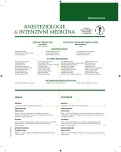Transcranial Doppler and brain death
Authors:
M. Matias
Authors‘ workplace:
Klinika anesteziologie, resuscitace a intenzivní medicíny 1. LF UK, Všeobecná fakultní nemocnice, Praha
Published in:
Anest. intenziv. Med., 27, 2016, č. 1, s. 32-35
Category:
Postgraduate education - ECHO didactics
Overview
Transcranial ultrasonography (transcranial doppler, TCD) is a generally underused ultrasound application despite its relative simplicity, low inter-observer variability and a steep learning curve.
A typical flow pattern on TCD is an accepted method for confirmation of irreversible brain death prior to organ donation according to the current Czech law. However, TCD in this indication has to be performed by a competent specialist in radiology, neurology, neurosurgery or paediatric neurology with minimum 3 years of proven experience with TCD.
Despite this specific competency problem of brain death confirmation, TCD remains a valuable method for estimation of progression of intracranial hypertension to brain death and helps with the timely application of other confirming methods for the routine ICU ultrasound user.
Keywords:
transcranial ultrasound – Doppler – brain death – intensive care
Sources
1. Chang, J., Tsivgoulis, G., Katsanos, A., Malkoff, M., Alexandrov, A. Diagnostic Accuracy of Transcranial Doppler for Brain Death Confirmation: Systematic Review and Meta-Analysis. AJNR, 2015.
2. Monteiro, L., Bollen, C., van Huffelen, A., Ackerstaff, R., Jansen, N., van Vught, A. Transcranial Doppler ultrasonography to confirm brain death: a meta-analysis. Intensive Care Med., 2006, 32, 12, p. 1937–1944.
3. Ducrocq, X., Braun, M., Debouverie, M., Junges, C., Hummer, M., Vespignani, H. Brain death and transcranial Doppler:experience in 130 cases of brain dead patients. J. Neurol. Sci., 1998, 160, 1, p. 41–46.
4. Aggarwal, S., Brooks, D., Kang, Y., Linden, P., Patzer, J. Noninvasive monitoring of cerebral perfusion pressure in patients with acute liver failure using transcranial doppler ultrasonography. Liver Transpl., 2008, 14, 7, p. 1048–1057.
5. Ducrocq, X., Hassler, W., Moritake, K., Newell, D., von Reutern, G., Shiogai, T., Smith, R. Consensus opinion on diagnosis of cerebral circulatory arrest using Doppler-sonography, Task Force Group on cerebral death of the Neurosonolgy Research Group of the World Federation of Neurology. Journal of the Neurological Sciences, 1998, 159, p. 145–150.
6. Llompart-Pou, J., Abadal, J., Güenther, A., Rayo, L., Martín-del Rincón, J., Homar, J., Pérez-Bárcenal, J. Transcranial Sonography and Cerebral Circulatory Arrest in Adults: A Comprehensive Review. ISRN Critical Care, 2013, Article ID 167468, 6 pages.
Labels
Anaesthesiology, Resuscitation and Inten Intensive Care MedicineArticle was published in
Anaesthesiology and Intensive Care Medicine

2016 Issue 1
Most read in this issue
- Metabolic consequences of bowel damage in intensive care
- Initial experience with adenosin-induced circulatory arrest during cerebral artery aneurysm surgery – first experience
- Consciousness as a cosmic phenomenon
- Evaluation of Patients With Suspected Acute Pulmonary Embolism: Best Practice Advice From the Clinical Guidelines Committee of the American College of Physicians
